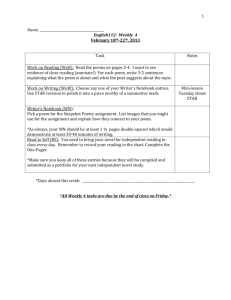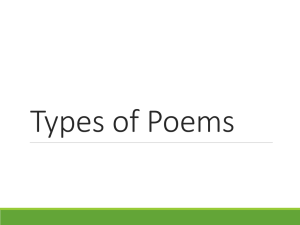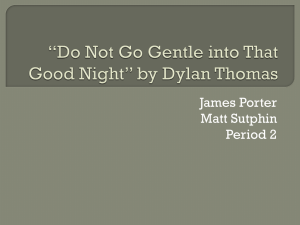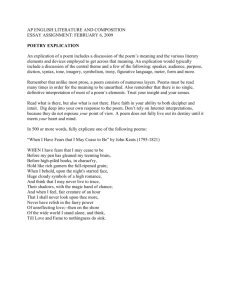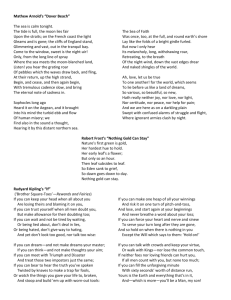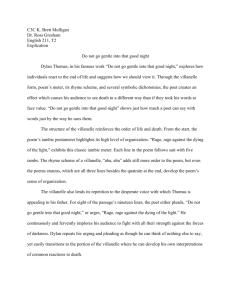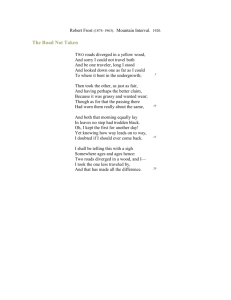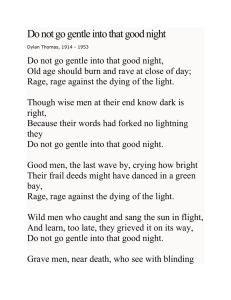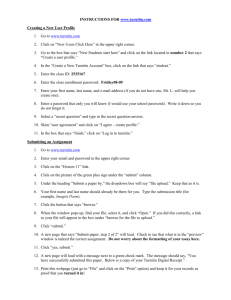Do not go gentle into that good night
advertisement
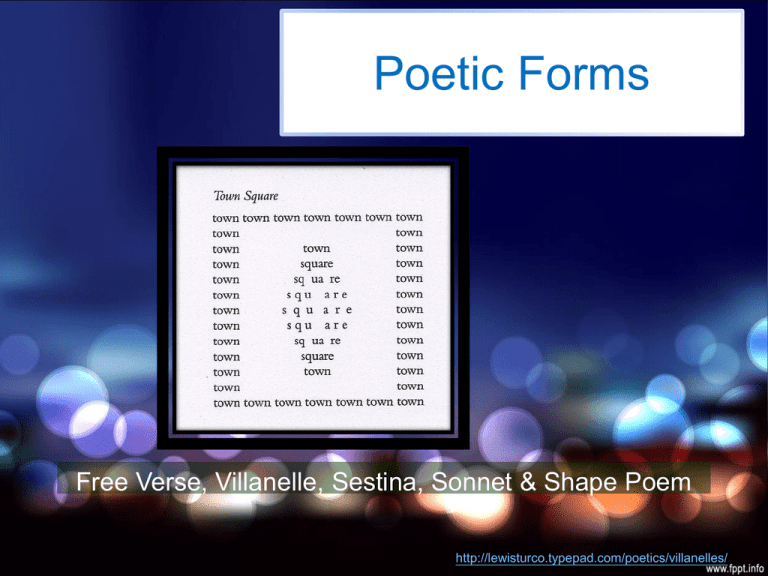
Poetic Forms Free Verse, Villanelle, Sestina, Sonnet & Shape Poem http://lewisturco.typepad.com/poetics/villanelles/ 0-1. Responses Outline 0-2 Poetic Form Free Verse • 1.【Identity G5-6-9】 Walt Whitman “A Noiseless Patient Spider” (p. 1106) Vilanelle • 2.【Life/Death G7-8-10】Thomas, Dylan “Do Not Go Gentle into That Goodnight” (p. 878) Sonnet Sestina Shape • 3.【Society/Art G12-11】Gwendolin Brooks “First Fight, Then Fiddle” (898) • 4.【Love G1-2】Shuttleworth, Ciara. “Sestina” (881) • 5.【Identity G3-4】Cummings, E. E. “l(a” (883) Housekeeping • Grouping – adjustment by Kate? (Opinions expressed by email before 1/16) • Makeup journals – due by 1/16 • Responses to journal 3– delayed • Group Discussion report – comparison should start with a main argument, which is supported by the analysis that follows. Evidence, Organization. • There will be an online questionnaire; please help!!! • Poetry 5: Poetic Form and Dramatization Poetic Forms Traditional Poetry Open Form Meter, rhyme, stanza Free verse Ballad, Sonnet, Villanelle, Sestina Shape Poem Blank verse (no rhyme) A Noiseless Patient Spider 【Identity G5-6-9】 Walt Whitman (1819 - 1892) A noiseless patient spider A noiseless patient spider, I mark'd where on a little promontory (隆突) it stood isolated, Mark'd how to explore the vacant vast(1) surrounding, It launch'd forth filament, filament, filament, out of it self, Ever unreeling them, ever tirelessly speeding them. (2) apostrophe And you O my soul where you stand, Surrounded, detached, in measureless oceans of space, Ceaselessly musing, venturing, throwing, seeking (4) the spheres to connect them, Till the bridge you will need be form'd, till the ductile (柔軟的) anchor hold, Till the gossamer thread you fling catch somewhere, O my soul. (1. consonance, 2, assonance, 3. alliteration, 4. internal rhyme) A Noiseless Patient Spider: Discussion Questions • Symbol: What are the implications in comparing the soul to a spider? • Compare & Contrast: How are the activities of the spider similar to and different from those of the soul? • Figurative language: What are the effects of the repetition of his apostrophizing (頓呼) the soul ("O my soul")? • Sound effects? • Form: the pattern of free verse depends a lot on repetition (with variation) of different poetic elements. Why are there not as many repetitions in the second stanza? From stanza one to two, we see similar kind of variation of line length (which gets longer and longer). What effects are achieved here? Poetic Form and Techniques Free Verse •Unrhymed; no regular length; •Rhythmical lines varying in length •Patterns produced through repetition and parallel grammatical structure. •Apostrophe-- figure of speech in which an absent person, a personified inanimate being, or an abstraction is addressed as though present; -- the poet talks to (and personifies) the one addressed. A noiseless patient spider as a symbol • Figurative language: the soul, something active (like spider working), brought closer and cherished (via apostrophe). • Symbol: a spider the soul: – difficult, quiet and laborious work in setting up structures out in empty space. (launching, unreeling/spinning, speeding) – The soul’s action: musing, venturing, throwing, seeking, bridging, anchoring – intellectual and various. • Sound effects? –signifying their actions (slow, soft, quiet, continuous and non-violent). • Form: rhythm – regular; increasing line lengths -the extension of their threads and connections. • (for your reference: http://www.cc.nctu.edu.tw/~sheen/al/notes.html#2 ) Extension Questions: A Noiseless Patient Spider • 1. If you were going to compare yourself to an animal, what animal would you choose? Why? • 2. Can you relate to the action of spinning a web, or making connections, in the world or universe? Is it difficult for you? • 3. The song "Sound of Silence" can be seen as another search for inner soul--by talking to darkness as an old friend. Please pay attention to the contrasts in imagery between darkness and light, silence and sound. The phrase "sound of silence" is an oxymoron; can you explain why? Walt Whitman • A printer, teacher, journalist poet hospital worker, government clerk, later fired because of his poetry. • Publishes Leaves of Grass in 1855, later revised 8 times. • A free thinker, sometimes without regular jobs. (source) • portrait: from an 1854 engraving by Samuel Hollyer Dylan Thomas (1914 – 1953) 【Life/Death G7-8-10】 Do not go gentle into that good night Do not go gentle into that good night, sleep/restful death; metaphor Old age should burn and rave at close of day; Rage, rage against the dying of the light. Accepting death Though wise men at their end know dark is right, Because their words had forked no lightning they Creates no impact Do not go gentle into that good night. Good men, the last wave by, crying how bright Their frail deeds might have danced in a green bay, Rage, rage against the dying of the light. regret Do not go gentle into that good night (2) Wild men who caught and sang the sun in flight, And learn, too late, they grieved it on its way, Do not go gentle into that good night. Grave men, near death, who see with blinding sight Blind eyes could blaze like meteors and be gay, Rage, rage against the dying of the light. And you, my father, there on the sad height, Curse, bless me now with your fierce tears, I pray. Do not go gentle into that good night. Rage, rage against the dying of the light. Live life wildly & celebrate it Do not go gentle into that good night Questions 1. Speaker, Tone and Main Idea: -- Who is the speaker speaking to? What is his main message? How would you describe his tone? -- How does the speaker try to explain that there is a need to "burn and rave" at old age? What does he say that wise men, good men, wild men and grave men do? 2. Language and Metaphor: -- If we further examine the examples the speaker give, we will find that the four kinds of men stay active and passionate at their old age for different reasons: what are they? 3. Pattern and Overall Meaning: -- How is the speaker’s idea developed? What is view of life presented? -- Do you find the poem passionate, selfish, or desperate & hiding a great sense of futility? Response Patterns wise men good men wild men grave men accept regret know dark is right Because their words had forked no lightning -Crying how bright /Their frail deeds might have danced in a green bay caught and sang learn too late, they grieved the sun in flight it[the sun] on its way Blind eyes could with blinding sight blaze like meteors and be gay Wise Men, Good Men, Wild Man and Grave Man Stanzas 2 and 3 deal with men who have failed to achieve the ends they "have aimed at. -- "Because their words had forked no lightning" (5) -- “because their "frail deeds" never "danced" (8). Stanzas 4 and 5 deal with men who have achieved their aims, but either regret their success or is losing it. -- "Wild men," in their hedonist actions, regret "they grieved it on its way" (10-11). --"Grave men," who may have spent their lives in the gloomy contemplation of life's sorrows, see the possibility of “gaiety“ (“blaze like meteors and be gay”) with blinding sight (about to lose it). Father and Son: use of oxymoron And you, my father, there on the sad height, Curse, bless me now with your fierce tears, I pray. Do not go gentle into that good night. power Rage, rage against the dying of the light. futility Dylan Thomas • Born in Wales. Wrote several poems on his birthdays which are to do with death. • Thomas: under strong influence of his father. • "the only person I can't show the little enclosed poem to is, of course, my father, who doesn't know he's dying" (Letters 359) Dylan Thomas’s Father David John, known as D. J. According to biographer Paul Ferris, D.J. was 1."an unhappy man... a man with regrets" (27); born with brains and literary talent, his ambition was to be a man of letters, but he was never able to advance beyond being "a sardonic provincial schoolmaster" in South Wales, feared for his sharp tongue (2633). 2.After his first serious illness, though--cancer in 1933--"A mellowing is said to have been noticeable soon after; his sarcasm was not so sharp; he was a changed man" (104). As he grew more chronically ill in the 40's, mostly from heart disease and with one of the complications being trouble with his sight, the mellowing intensified: As Ferris puts it, "It must have been [D. J.'s] backbone of angry dignity that his son grieved to see breaking long after, when he wrote 'Do not go gentle into that good night'" (27), and the poem is "an exhortation to his father, a plea for him to die with anger, not humility" (259). (MARC D. CYR, DYLAN THOMAS'S "DO NOT GO GENTLE INTO THAT GOOD NIGHT": THROUGH "LAPIS LAZULI" TO KING LEAR” ) Literary Techniques (4): Poetic Form— Villanelle A chiefly French verse form running on two rhymes and consisting typically of five tercets and a quatrain in which the first and third lines of the opening tercet recur alternately at the end of the other tercets and together as the last two lines of the quatrain. –line 1 = 6, 12, 18; line 3 = line 9, 15, 19. 一種源自法國的兩韻詩(由五個三聯句(tercet)及一 個四行詩(quatrain)組成;開頭三聯句的第一、三 行輪流出現於其他三聯句的最後一行、再一起出 現為四行詩的結尾兩行)。 two rhyming sounds: aba aba aba aba aba abaa. Literary Techniques (4): Poetic Form— Villanelle The beauty of villanelle – ". . . the form [of villanelle] has remarkable unity of structure. The echoing and reechoing of the refrains give the villanelle a plaintive, delicate beauty that some poets find irresistible." Difficulties of villanelle – "Since it has only two rhymed endings, the poem can easily become monotonous. The risks of monotony is increased by the incessant appearance of the refrains that constitute eight of the poems' nineteen lines -- nearly half of the poem. This skilled author of the villanelle, thus, is careful to achieve the maximum tonal range and to fit the refrains lines as naturally as possible into the logic of the poem" (The Heath Guide to Literature 637) e.g. One Art; Mad Girl’s Love Song Sound & Sense -- Do not go gentle into that good night spondee Do not go gentle into that good night, Old age should burn and rave at close of day; Rage, rage against the dying of the light. command Though wise men at their end know dark is right, Because their words had forked no lightning they No action Do not go gentle into that good night. Good men, the last wave by, crying how bright Their frail deeds might have danced in a green bay, Rage, rage against the dying of the light. action Scanning -- Do not go gentle into that good night (2) Wild men who caught and sang the sun in flight, And learn, too late, they grieved it on its way, Do not go gentle into that good night. Grave men, near death, who see with blinding sight Blind eyes could blaze like meteors and be gay, Rage, rage against the dying of the light. And you, my father, there on the sad height, Curse, bless me now with your fierce tears, I pray. Do not go gentle into that good night. Rage, rage against the dying of the light. Questions for you … • What would you say to an aging elderly (relative or parent) if they are fading into the sunset? • Would you be able to categorize yourself as a wise man, good man, wild man and grave man? Or which would you aspire to be? • After reading two poems about death, which attitude would you possibly take if you were to face death? Or with the awareness of its inevitability, would you cherish life more and in what ways? First Fight, Then Fiddle Gwendolin Brooks (1949) 【Society/Art G12-11】 First Fight. Then Fiddle. First fight. Then fiddle. Ply the slipping string A With feathery sorcery; muzzle the note B With hurting love; the music that they wrote B Bewitch, bewilder. Qualify to sing A Threadwise. Devise no salt, no hempen thing A For the dear instrument to bear. Devote B The bow to silks and honey. Be remote B A while from malice and from murdering. A But first to arms, to armor. Carry hate C In front of you and harmony behind. D Be deaf to music and to beauty blind. D Win war. Rise bloody, maybe not too late C For having first to civilize a space E Wherein to play your violin with grace. E Muzzle & Thread/Hemp • The music that they wrote? • Image source “First Fight, Then Fiddle” Questions • Overall Meaning & Structure: What do it mean: “first fight, then fiddle”? What does “fight” & “fiddle” mean respectively? Why does the poem do it the other way around (reversing the order)? Is either completely rejected? • Form: Petrarchan sonnet –effects (turn?) – – – – Rhyme: masculine rhyme, feminine rhyme Rhythm & meter: iambic pentameter Sound: alliteration Enjambment vs. short lines Gwendolyn Brooks (1917 ~2000; Chicago) Poem published in 1949 “First Fight, Then Fiddle”: Fiddle • sense – plays the music which is sweet, melodious and mesmerizing (feathery sorcery, bewitch, bewilder), – filled with repressed emotions, – detached from cruel reality (malice and murdering) – but not sharp-sounding, coarse but lively tunes. – sound – repetition of melodious & nasal sounds such as [m], [ing], [ind], [sl]; – use of enjambment Why not? Other’s music. “First Fight, Then Fiddle”: Fight • sense – [But] One must go to war (arms and armor—to fight and protect oneself), carrying hate in front and harmony behind (as support) purpose: -- “to civilize a space” where playing music is possible • sound –short one-syllable words • use of short imperatives: “win war. Rise bloody.” Why not? Other’s music. Sestina (2010) Ciara Shuttleworth 【Love G1-2】 You Used To Love Me well. Me, too, used . . . well. . . you. Love, Well, you— me— Used Love to . . . love me. You, Too Well used, to . . . well . . . love. You Used me. used Love well. Me, too. You! You Used to Love me well. 2 speakers A: You Used To Love Me well. B. Used Love to . A. You Used me. B. Me, too, used you. . . A. Love me. B. Used Love well. Me, too. You! A. You Used to Love me well. Sestina Sestina: a fixed verse form consisting of six stanzas of six lines each, normally followed by a threeline envoi. (Wikipedia) Source: Wikipedia Sestina: Questions • 1. How many speakers are there in this poem? When does one stop speaking and another begin? • 2. What is the role of punctuation in “Sestina”? Can you describe the tones of each stanza? 【Identity G3-4】 l(a (1958) Cummings, E. E. l(a l(a le af fa ll s) one l iness l(a: Questions • What does the poem mean and how are the meanings conveyed through the image, the words and the shape of the poem? • “A leaf falls. Loneliness.” Why is this one not a poem, but “l(a” is? Is there meter or rhythm in the poem? l(a: loneliness=singleness • the image = a leaf • the words = la, le, fa, af, ll (words falling and reversing), i-ness, I • the shape of the poem = “l” • Regularity (meter) in the falling and multiple meanings of the characters. References • Owens, Clarke W. “Brooks's First Fight. Then Fiddle.” The Explicator 52.4 (Summer 1994): 240. Poetry I: Identity and Daily Life Tone & Sound Pattern “We Real Cool” “Those Winter Sundays” “Stopping By Woods” • Short lines w. stresses & pauses • Repetition showing regret • Soft-spoken and rhythmic; repetition “I’m Nobody…” • Soft-spoken, secretive “This is Just to Say” • Casual, intimate “The Word Plum” • Pleasure w/ a variety of sounds “Noiseless Patient Spider” Poetry II: Nature and Love Relations Diction & Figurative Language Metaphor Repetition, Ambiguity and Twisted Syntax Simile Imagery Symbol • Linda Pastan “Marks” • “A Noiseless Patient Spider” • Behn, Aphra “On Her Loving Two Equally” • Burns, Robert “A Red, Red Rose” • Wordsworth “I Wandered Lonely as a Cloud” • Mary Oliver “Wild Geese” • “Wise Geese” “Spider” “Snake” Imagery, Symbolism, Irony Poetry III: Society and Mortality “The Sick Rose” • What the worm and “bed of crimson joy” represent • Alteration between 2-syllable feet and 3-syllable feet First Fight, Then Fiddle “Harlem” • A series of rhetoric questions put in terms of metaphors “Because I could not stop for Death---” • Death personified as a gentleman and a bridegroom • Changes in the speaker’s tone “Do Not Go Gentle into That Goodnight” • The four types of responses; the form of villanelle “Stop all the clocks, cut off the telephone” • The use of public mourning to represent one’s own grief; use of hyperbole and imperatives Poetry IV: Arts and Modern Society Rhyme, Rhythm and Symbol “In a Station of the Metro” • Beauty of Transience & Science • Imagism Musee des Beaux Arts (1938) • Art vs. Sufferings The Dance (1962) • Art vs. Physical Pleasures; Internal rhymes Anecdote of a Jar (1923) • Art/Artifice vs. Nature; Symbol; Rhyme Final Exam (3 hours) • Close Analysis 30% (each 10%) – the poems and the play • Short Essay Questions (each 15%) -- 30% • Essay Questions 40% (each 20%) – A. comparison – B. on the 3 endings of Pygmalion: what does the play mean if it ends at the end of Act 3, Act 5, and w/ the postscript? Title • Text
